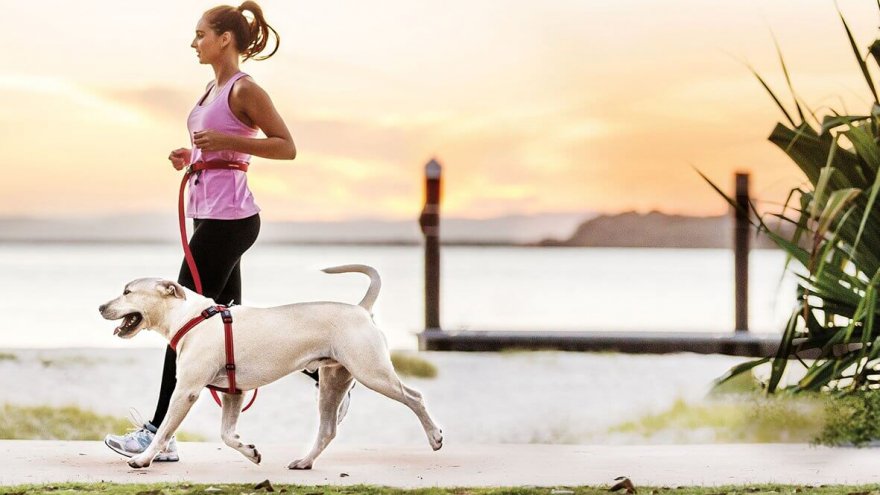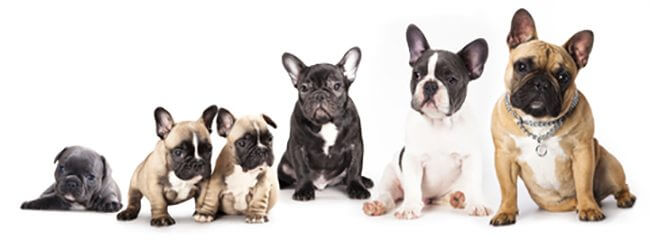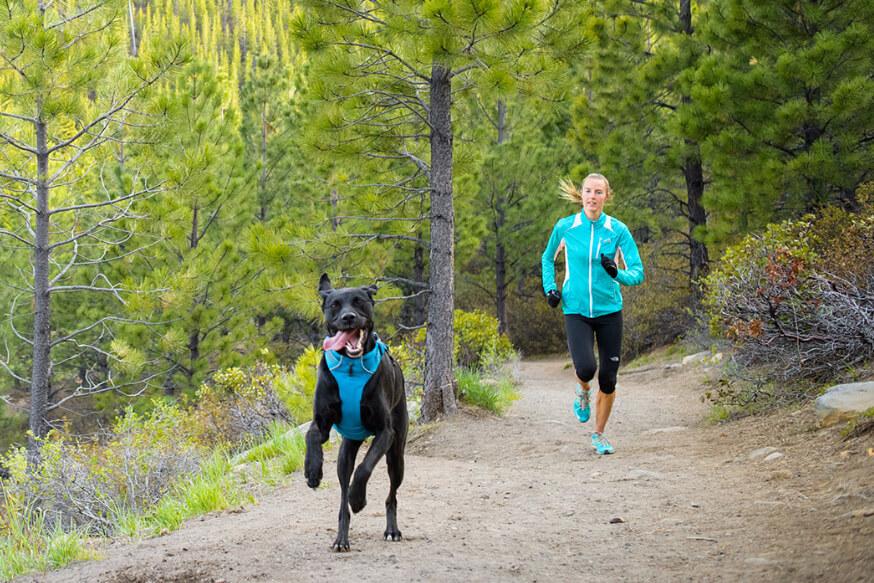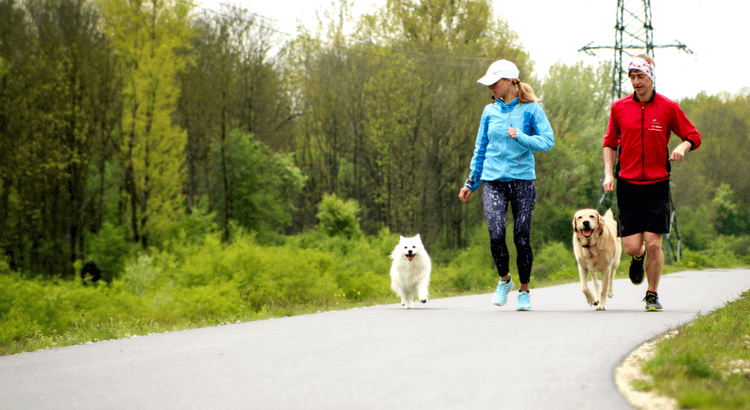6 Tips for Training Your Dog To Run With You!

There are many considerations prior to jumping into running with your dog. If you are planning to get a puppy (or choose a dog to adopt) with specific attention to the appropriate breed for the type of running you do, you may want to gather more information on the best dogs for running.
In last week’s article, Best Running Dogs, we investigate which breeds are most adept at certain types of running. What if you already have a dog and are contemplating training your dog to run with you. What then?
There are some definite things to consider.
Be Careful About Running Certain Breeds
First, dogs who are brachycephalic are “short-headed.” These breeds, such as a pug or a bulldog, tend to have a short snout. Since this can cause respiratory distress, they are not good runners.
Knowing things like this about your dog breed is important to keep them healthy and safe. Most dogs like this are best equipped for nothing more aggressive than a brisk walk.

If you have a cold weather-loving dog, such as a Siberian Husky or an Alaskan Malamute, you should not run your dog in hot weather.
This is also true of some large, black dogs. If your dog tends to overheat quickly, you should only run early in the morning, at dusk, or after dark during the hot months.
Puppies!
Everyone loves a puppy. And what’s not to love? Puppies are adorable and cuddly. However, puppies should not be run until cleared by a veterinarian.
Depending on the breed and size of the dog, a puppy should not be introduced to structured running until they are between six and eighteen months old.
Running a puppy too early can cause problems to the dog’s growing joints and muscles. The last thing you want to risk is hurting your new best friend!
6 Tips for Training Your Dog To Run With You:
1. Ball Control!
2. Hydration For You & Your Pooch!
3. Recovery x 2
4. Low Impact For You Both
5. Keep It Fresh, Keep It Exciting
6. Look After Your Shoulders
Beware Of Weather And Terrain
Heat and humidity can cause many dogs to struggle. You should be very careful in hot weather. If you are going to be out for more than a short while in warm temps, you should always carry water for your dog and offer it frequently.
Know that in hot weather a paved road or sidewalk can burn your doggie’s paws. Some people prefer to run their dog in grass or on soft trails for this reason.

Although many breeds are made for cold weather there are also dogs that don’t do well in sub-zero temps.
Remember: you have layers and layers of performance gear to keep you warm on an extremely cold and windy day. All your pup has is his fur and his feet are virtually unprotected from the elements.
Take Care Of Business First
When training your dog to run with you it will be helpful (and less distracting) if your dog can go potty before you start. Does that sound easier said than done? Believe it or not, if your dog has fairly routine potty schedules you can help him or her to learn how to “go first.”
First thing in the morning all dogs have to pee, right? So take your dog potty and then, if he normally poops after he eats, go for a short run then. Make sure you use the words “go potty” like you did when training him to go outside. Some people actually say, “Let’s go for a run!” Then, before getting the running gear ready, “go potty first” follows.
Just like humans, some dogs find themselves feeling the urge to poop after they start running. If this is your dog you have two choices. One is to plan a fairly short out and back to warm up, so you can pick up the poop, bring it home to toss in the trash, then finish the run. The other is to just resort to carrying it.
Did you know they make little backpacks for dogs so they can carry their own poop? Super handy!
Learn To Read Your Dog
Just like that best human friend you run with, your dog will have a running body language and you need to understand it. Your dog counts on you to make good decisions for him. A dog will run too hard and too long in order to please you, the master. Be careful not to let that happen.
Pay attention to your dog. If pup is lagging behind you need to slow down or take a break. If he is panting hard you might need to slow down. If tail is wagging and he is trotting right beside you, likely you are doing just fine.
Are you thirsty? Then so is he!
Vary Your Workouts
Just like you, your dog will benefit from workouts of varying lengths and distances. It’s okay to go for an easy run now and then. It is also good to do some short runs and some longer ones.

Just like for a human if you run long one day, your dog would benefit from a shorter run (or a different type of workout) the following day.
Remember: playtime is a workout for your dog.
The Equipment You Will Need
There are many different types of collars and harnesses made for running your dog. I prefer a harness but some people do use collars. You should not use a retractable leash for running because it gives your dog the idea that he can have free reign to run ahead.
Most runners prefer a hands free leash. These have a waist belt for the runner so the leash can attach to that.
Some dogs can learn to drink from a water bottle. For other dogs, you will want to carry water and a collapsable drinking bowl. Unless you are doing very short runs, you need to have water available for your buddy.
Also plan on how you will carry your clean and “full” poop bags. Running with a handful of poop isn’t fun, but leaving the poop on someone’s lawn just is not cool!
*This article was written in collaboration with:
Latest Articles
 Is Running on a Treadmill Easier Than Running Outside?Runners have their own preferences, whether it is treadmill running, running outside on the road, or exploring trails. So...
Is Running on a Treadmill Easier Than Running Outside?Runners have their own preferences, whether it is treadmill running, running outside on the road, or exploring trails. So... Is It OK to Use Trail Running Shoes on the Road?While trail running shoes can be used on roads, especially in situations where a runner encounters mixed terrains or pref...
Is It OK to Use Trail Running Shoes on the Road?While trail running shoes can be used on roads, especially in situations where a runner encounters mixed terrains or pref... How to Fix Sore Quads After Running?Rest, ice, gentle stretching, and over-the-counter pain relievers can help soothe sore quads after running. Also, ensure ...
How to Fix Sore Quads After Running?Rest, ice, gentle stretching, and over-the-counter pain relievers can help soothe sore quads after running. Also, ensure ... 10 Fruits With The Most Electrolytes to Replace Sports DrinksThese fruits are high in electrolytes such as potassium, magnesium, and calcium, essential for hydration, muscle function...
10 Fruits With The Most Electrolytes to Replace Sports DrinksThese fruits are high in electrolytes such as potassium, magnesium, and calcium, essential for hydration, muscle function...

